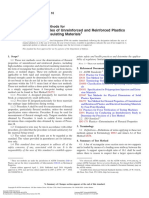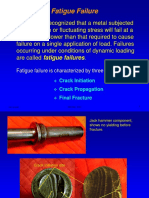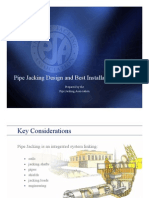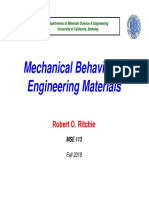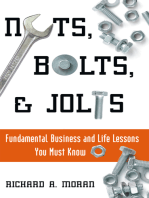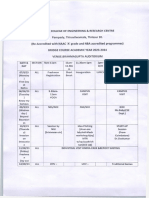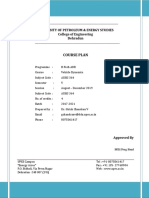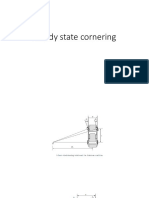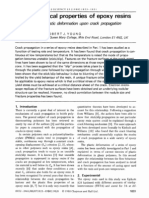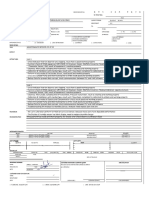Bolted Joints
Bolted Joints
Uploaded by
Girish ChandranCopyright:
Available Formats
Bolted Joints
Bolted Joints
Uploaded by
Girish ChandranCopyright
Available Formats
Share this document
Did you find this document useful?
Is this content inappropriate?
Copyright:
Available Formats
Bolted Joints
Bolted Joints
Uploaded by
Girish ChandranCopyright:
Available Formats
Ajax Fasteners 2001
AN ENGINEERING INSIGHT TO THE FUNDAMENTAL BEHAVIOUR
OF TENSILE BOLTED JOINTS
by
Dr Saman Fernando
Ajax Technology Centre
76-88 Mills Road, Braeside Vic 3195
straightforward. The bolt does not need to maintain a
INTRODUCTION specific tensile load. In this case the tensile load is
applied only to prevent the nut from loosening. When
The threaded fastener (nut and bolt) has played a the shear load on the joint changes the corresponding
significant role in the industrial revolution even stress field in the bolt also changes. Under dynamic
though the exact date of its conception is not loading this can lead to possible fatigue failure of the
known. The concept of a helical thread was first bolts.
introduced by Archimedes in the 3rd century B.C.
AJAX FASTENERS
Some archeologists argue that the threaded Consider however that, a shear force can be
fastener was in existence even before Archimedes transmitted with the help of friction forces
at the Hanging Gardens of Babylon. It is perpendicular to the bolt axis, which are created by
accepted that the common forms of threaded the tensile force on the bolt and friction between the
fastener assemblies have been in existence for at plates/bolt/nut etc. Even though the joint supports a
least 500 years. Threaded fasteners are probably shear load, in this instance, it is considered as a tensile
the best choice to apply a desired clamp load to joint or more specifically as a friction joint.
assemble a joint, at a low cost, with the option to Essentially, for this joint the body of the bolt need not
disassemble if and when necessary. Furthermore, touch the joining members. In a friction joint a
the simplicity of its mechanism of developing and variation in the shear force does not cause a variation
maintaining the desired clamp force made it very on the tensile force on the bolt. As a result for
popular and it has become one of the most dynamic loading situations a friction joint will
accepted engineering products. In a negative eliminate possible fatigue failure.
sense, this simplicity may have made some users
complacent and therefore to disregard some In most situations involving dynamic loading the
important issues associated with a bolted joint. tensile joint becomes a requirement and more
attention is needed in the design of this joint.
Therefore the rest of the discussion will be focussed
BOLTED JOINT on the tensile joint.
In order to shed some light on to the behaviour of a
generic tensile bolted joint a comprehensive 3D Non-
linear Elasto-Plastic Finite Element model analysis
has been conducted. Results of this work will be
published in the near future. Although most of the
complexities of a generic tensile bolted joint can be
addressed with the above comprehensive approach,
cost and the effort requires does not qualify it as a
AJAX FASTENERS
Based on the service loads there are two types
generic engineering tool for wider applications.
Therefore, an attempt has been made to develop a
simple analytical method using fundamental theory
and first order approximations. Although the
bolted joints. In tensile joints the bolts are loaded approach presented here can be substantiated and
parallel to the bolt axis while in shear joints the calibrated by the aforementioned FEM analysis and
bolts are loaded predominantly perpendicular to experimental data, the emphasis made in this
the bolt axis. For example the connection of two publication is to qualitatively highlight the importance
flanges of a pressure vessel constitute a tensile of the various critical parameters associated with a
joint while the connection of a beam to a column generic tensile bolted joint.
can be considered as a shear joint.
In a typical shear joint the bolt acts as a shear pin. The optimum pre-tension of a bolt in a joint has
The analysis of a shear joint is quite been a subject of confusion.
Page 1 of 13 Ajax Fasteners 2001
Ajax Fasteners 2001
IMPORTANCE OF PRE-TENSION Type A Joint:
In order to emphasize the importance of pre-
tension or pre-load on the bolts in a bolted joint, This joint may also be represented as a system of
the following first order analysis based on springs as shown in Figure 2.
fundamental engineering principles is carried out. Fa
In a typical bolted joint one of the main functions Fc ,ka
of the bolt is to maintain an adequate positive
clamping force during the service life of the joint Fb
in order to prevent leaks, relative movement, wear
and fretting, etc. To achieve a particular service
kb When Fa = 0
life requirement for a bolted joint it is very kc Fb = Fc = Fi
important to understand the effect of bolt pre-
tension (Fi) and the applied load (Fa) on the
Clamping force (Fc). Fb
AJAX FASTENERS
For simplified analysis purposes, two types of
tension joint load configurations may be Fc Fa
considered:
a) An external load is applied at the surface Figure 2: Mechanical representation of Type A
adjacent to the nut and the head (Type A, Figure joint
1(a)), The bolt is represented by a tension spring of stiffness
b) An external load is applied at the jointed kb while the joint is represented by a compression
interface (Type B, Figure 1(b)). These two types spring of stiffness kc. With initial pre-load (Fi) and no
share the applied load differently between the external load applied, the spring system will be in
fastener and the clamping force. However, in equilibrium with,
reality a typical joint will be a combination of the Fb = Fi (1)
above Type A and Type B Joints. Fc = Fi (2)
where Fb is bolt tension and Fc is clamping force.
Ab .Eb
kb = (3)
Lb
where Ab is the effective stress area of the bolt, Eb
Youngs modulus of bolt material and Lb the effective
length of the bolt.
2
Ab
4
D( ) (4)
where D is the nominal diameter of the bolt.
Figure 1(a): Type A Joint
Ac .Ec
kc = (5)
Lc
where Ac is the effective stress area of the joint
AJAX FASTENERS members, Ec Youngs modulus of joint material and
Lc the effective length of the joint.
If Dj < Db
2
Ac =
4
(
D j Dh2 ) (6)
Figure 1(b): Type B Joint where Dj the joint diameter, Db bolt under head
/washer bearing diameter and Dh the hole diameter.
If joint thickness t <8D and Db < Dj < 3Db,
Page 2 of 13 Ajax Fasteners 2001
Ajax Fasteners 2001
2 Dj Db L g L2g
Ac = (Db Dh2 ) +
8 Db
1
+
100
(7 )
4 5
If Dj > 3Db then,
Lg
2
Ac = Db + Dh2 (8)
4 10
where Lg is the grip length of the joint.
In general, due to the larger stress area (Ac>Ab), kc
> kb (Eqn (3), (5)). The applied force Fa will
generate an overall displacement as shown in
the Figure 2. This displacement imparts an
additional load of kb. on the bolt.
AJAX FASTENERS
The new bolt tension may now be represented by,
Fb = Fi + kb.. (9)
The same displacement relaxes the compression
force on the joint members by kc. resulting a new
clamping force of:
Fc = Fi kc. (10)
For the equilibrium of forces:
Fa = Fb - Fc = kb. + kc.. (11)
The resultant overall joint stiffness ka can be
defined as;
Fa = ka. (12)
By substituting (12) in (11);
ka. = kb. + kc.
ka = kb + kc (13)
Combining (12) and (13)
Fa Fa
= = (14)
k a (k b + k c )
by substituting (14) in (9) and (10) respectively;
AJAX FASTENERS
Fb = Fi +
k b .Fa
(k b + k c )
(15)
k .F
Fc = Fi c a (16)
(k b + k c )
Page 3 of 13 Ajax Fasteners 2001
Ajax Fasteners 2001
In order to obtain a feel for the relative magnitudes of
Equation (15) confirms that only a component of the above parameters the following example is given;
the applied load is contributing to increase the Example 1:
tension of the bolt. Typically kc is larger than kb M20:Property Class 8.8 Bolt
and hence, the increase in the bolt tension will be (Property Class X .Y is defined as Ultimate Tensile Strength
less than the decrease in the clamping force. UTS =X *100 MPa and Proof Strength YS= 0.1* Y * UTS)
Therefore the parameter kc/kb has a significant UTS = 8 * 100 = 800 MPa
impact on the performance of the joint. YS = 0.1 * 8 * 800 = 640 MPa.
The Figure 3 shows the relationship between Fi, Effective Area = 245 mm2
Fb, Fc and Fa for bolted joint in the elastic range. Proof Load = 147kN
Breaking Load = 203kN
Bearing Diameter (Db) = 40mm
Load Effective Grip Length = 100mm
Youngs Modulus = 200GPa
kb(eq.(3)) =245*200/100 kN/mm
kb .Fa
Fb = Fi + =490 kN/mm
kb + kc
Fi AJAX FASTENERS Joint:
Youngs Modulus =200GPa
kc .Fa Joint Diameter (Dj) > 120mm
Fc = Fi Hole Diameter (Dh) =22mm
kc + kb Length =100mm
Effective Area (eq(8)) =1583.5mm2
kc (eq.(5)) =1583.5*200/100 kN/mm
0 Fa Load =3167kN/mm
Fa0
Note: In reality the bolt effective-length will be
Figure 3: Variation of Fb and Fc with Fa in the slightly larger than the joint effective-length. Joint
Elastic region effective area is based on using a high tensile washer
on either end.
From this graph it can be seen that Fc = 0 when
(k b + k c ).Fi
Fa 0 = . (17) Now, kc/kb = 3167/490 = 6.46.
kc
For most common applications this number is
This relationship proves that as high as possible between 4 and 8.
pre-tension Fi will provide the best load carrying
capacity for the joint. As discussed earlier, one of Now maximum clamp load Fimax is (eq. (19));
the main functions of a fastener is to keep the joint F y .k c
Fi max =
together. Therefore, it can be considered that the (k b + k c )
joint is failed when the applied load reaches Fa0. 3167
= 147
( 490 + 3167)
The bolt tension when Fc = 0 is (combining (15),
(16) and (17)), = 127.3kN
This gives the maximum pre-tension load for this joint
Fb0 = AJAX FASTENERS
(k b + k c ).Fi
kc
= Fa 0 (18) as 127.3/147*100% = 86.6% of the proof load.
The corresponding maximum applied load for the
shall be smaller than the breaking load of the
fastener. separation of the joint is (eq.(18));
(k b + k c ).Fi
For clamping load to become zero before the bolt
Fb 0 = = Fa 0 = 147kN, i.e., the proof
kc
reaches yield;
load of the fastener. This confirms that the tensile
Fy .k c
Fi < (19) load applied on the joint at separation will be equal to
(k b + k c ) the load on the fastener.
where, Fy is the yield strength of the fastener.
Page 4 of 13 Ajax Fasteners 2001
Ajax Fasteners 2001
The Load vs Displacement graph for the above joint has failed the bolt is still far from its yield load.
case is shown in Figure 4. If the applied load is increased after separation of the
Load joint, the total applied load will then be transferred to
Fb=Fi+kb the bolt. The bolt load will increase at the same rate
as the increase of applied load. As the joint is already
Fimax kb separated, this will lead to further failure mechanisms
such as bolt bending, fretting, joint wear, fracture etc.
kc Fa=ka. It is now clear that this is not the most economical
way of using a bolt.
Fc=Fi-kc. As discussed earlier, in eq. (15,16) the ratio kc/kb is an
important parameter for a bolted joint. This
ka=kb+kc determines the contribution of applied load to the bolt
load. The larger this factor, the smaller is the effect
Figure 4: Load Displacement graph in the on the bolt. This implies that the thinner and longer
elastic zone. the bolts are better it is. However, it should be kept in
AJAX FASTENERS
Now, lets investigate what happens if the fastener
was under tensioned. For example only 30% of
mind that the load carrying capacity of a bolt is
proportional to the square of the bolt diameter and
therefore a reduction in diameter will have some
the yield load, Fi2= 0.3*147 = 44.1kN. negative effects. In general, a larger number of small
diameter bolts are better than a small number of larger
The force at separation is (eq.(18)); diameter bolts, especially under dynamic loading.
(k b + k c ).Fi 2
Fa 02 = Effect of Dynamic Loading:
kc
Most mechanical connections are subject to dynamic
Fa02 = (490+3167)*44.1/3167 = 50.9kN loads. Fluctuating components of Wind and
earthquake loads as well as some live loads in
This is a significant reduction from 147kN as
structures are of dynamic nature. Rotating and
calculated earlier. By reducing the pre-load from reciprocating machinery generates significant cyclic
127.3kN to 44.1kN (86.6% yield to 30% yield) the
loads. One of the main failure modes associated with
load carrying capacity of the joint has fallen from
cyclic loading is fatigue. The fatigue life of a bolt can
147kN to 50.9kN. However, it is important to be estimated by a combination of S-N and Sa vs Sm
notice that the bolt will yield at a joint load of
diagrams, where Sa is the fluctuating stress, Sm is
48.9kN even though the joint has already failed by
mean stress and N is number of cycles for failure.
that time due to separation. This theory is well established and reported
A graphical representation of the above process is elsewhere. A simple example is presented here in
shown in Figure 5.
order to highlight the importance of pre-load on the
Load fatigue life of a bolted joint.
k b . Fa Figure 6 shows the effect of the peak fluctuating stress
Fb = Fi +
kb + kc (Sa) on the lifetime of the product when subject to a
F imax regular cyclic load. The lifetime is given as the
Fb number of cycles that the product can undergo before
fatigue failure. As we decrease the magnitude of the
F i2
Fb AJAX FASTENERS
Fc = Fi
k c . Fa
kc + kb
fluctuating stress, in this case less than 421MPa, the
life time will approach infinity as it will not subject to
fatigue failure. Similarly, if we increase the peak
alternating stress the lifetime will decrease. In this
Fc Fa example, as the peak alternating stress approaches
772MPa, failure will occur around 103 cycles.
F a02 F a0
In general, wind and earthquake dynamic loads will
Figure 5: Effect of reduced pre-load. have irregular frequency and amplitudes. Although
the same theory stated here can be used to estimate the
As shown in Figure 5, when the pre-load is fatigue life the treatment would be somewhat
reduced from Fimax to Fi2 the separation load is complicated.
reduced from Fa0 to Fa02. In this case, when the
Page 5 of 13 Ajax Fasteners 2001
Ajax Fasteners 2001
Log Sa Case 1:
Pre-Load = Fi = 60% Fy = 121.8 kN
Axial loading stress in MPa k b .Fa
772 Fb = Fi +
(k b + k c )
634
Fb (mean) = 121.8+490*58/(3167+490)= 129.6kN
517 = 100*129.6/203 %Fy
421 = 63.8%Fy
Sm = 0.638 * 900 = 574MPa
(k b + k c ).Fi
Fa 0 =
kc
103 104 105 106 Fa0 = (490+3167)*121.8/3167 = 140.6 kN
Log N Fb = 81.2*490/(490+3167) = 10.9kN = 5.4% Fy
Figure 6: Peak alternating stress Savs Life N
cycles graph (S-N Curve) for Class 10.9 Steel Sa = 0.054*900 = 48.6 MPa
AJAX FASTENERS
Figure 7 shows the effect of peak alternating Case 2:
stress and the mean tensile stress on fatigue Pre-Load = Fi = 25% Fy = 0.25*203= 50.75kN
failure. As can be expected, when the mean stress k b .Fa
Fb = Fi +
reaches ultimate strength (Su), the sample will fail (k b + k c )
without any fluctuating load. On the other hand,
Fb (mean) = 50.75+490*58/(3167+490) = 58.5 kN =
when the peak alternating stress is 772 MPa and 28.8% Fy
mean stress is zero, it will fail around 103 cycles.
Sm = 0.288 * 900 = 259MPa
The effect of combining alternating and mean
(k b + k c ).Fi
stresses on fatigue life is shown in Figure 7. Fa 0 =
kc
1000 Fa0 = (490+3167)*50.75/3167 = 58.6 kN
Axial loading stress in MPa Fb= (58+81.2-58.6)+58.6-58.5= 80.7kN= 39.75%Fy
Sy
Sa = 0.3975*900 = 357.75 MPa
800
Sa The above parameters for Case 1 and Case 2 are
103~
shown in Figure 8. For Case 1, a pre-load of 60%Fy is
600 applied. The mean applied load of 58kN result in a
104~
mean bolt load of 129.6kN. An applied load of
105~ 140.6kN will separate the joint. The peak
400
k Load
106~
200 3.86
kb.Fa
44.76 Fb = Fi +
j Su kb + kc
0 42.0 27.75
200 400 600 800 Sy 1000
Sm Fb
AJAX FASTENERS
Figure 7: Sa vs Sm curve for class 10.9 steel.
To understand the effect of pre-load on fatigue
20.26
17.5
Fc = Fi
kc .Fa
kc + kb
life, the following example is considered:
Example 2:
Bolt:M20, Class 10.9, eff. grip length 100mm
Su = 1000MPa kb = 168kN/mm 20.3 48.7
Sy = 900MPa kc = 1050 kN/mm
Fa
20.0 28.0
Fy = 203kN Fa = 58 kN (mean)
Fu = 255kN Fa = 81.2kN (peak alternating) Figure 8: Loading diagram for example 2.
fluctuating component of the 81.2kN applied load
imparts a fluctuating bolt load of 10.9kN. As the total
Page 6 of 13 Ajax Fasteners 2001
Ajax Fasteners 2001
maximum applied load (58+81.2=139.2kN) is less TORQUE TENSION RELATIONSHIP:
than 140.6kN the joint will not separate under
applied load conditions. The mean (Sm) and peak Now that the importance of the bolt pre-tension is
fluctuating stress (Sa) for Case 1 are 574MPa and established it is important to investigate how this can
48.6MPa respectively. This point is shown as be reliably achieved.
point j in Figure 7 and is in the area where no
fatigue failure will occur. Torque has been considered synonymous with tension
In Case 2, the pre-load is only 25%Fy=50.75kN. in the past with the unavailability of an economical
This may be a result of tightening error of the bolt. and reliable bolt tensioning method. Several
As a result the clamp separation load is reduced to approximations has been used in the design of bolted
only 58.6kN. That means when the joint load of joints at varying success and confident level in order
58+81.2kN is applied, the joint will separate (this to relate the torque to tension.
may be considered as failure) and the load excess
of 58.6kN will be transmitted directly to the bolt. The Nut Factor approach is the most commonly used.
Under the mean load of 58kN, the bolt will The simplified torque tension relationship;
experience a mean load of 58.5kN resulting a T=K.D.F
AJAX FASTENERS
mean stress Sm of 259MPa. The fluctuating load where K Nut Factor, D Bolt Diameter and F is the
of 81.2kN imparts a fluctuating bolt load of Bolt Tension.
80.7kN resulting a peak fluctuating stress Sa of
357.3MPa. This point is shown as k in Figure 7. This formula can be further expanded to;
This point is clearly within the life span of 106 T = F.D.(K1+K2+K3). where K1, K2 and K3 are
cycles limit. This implies that the bolt will fail contributions due to bolt stretch, thread friction and
around 106 cycles. under-head/under-nut bearing friction respectively.
The following chart describes these parameters.
This example clearly identifies importance of
K
properly tightening the bolts in dynamic
situations. Reduction of pre-load from 60% Yield
to 25% Yield will alter the joint from no fatigue K1 K2 K3
failure to fatigue failure.
D p t D rt D b rb
A similar problem may occur if the bolts are over
tightened. The following example shows the Using energy balance principals a first order
effect of over-tightening the bolts. relationship between the torque (T) and Tension (F)
can be derived as follows;
Case 3:
If the initial pre-load is set up at 95% of the yield In a rotation of the nut by ;
load (Fi=192.9kN) in Case 1 of the previous work done by torque = T.
example, the bolt load at mean applied load (58 work done by tension = F.p /2
kN) is; work done by thread friction = Frt t/cos
Fb = 192.9+490*58/(3167+490)= 200.7kN work done by under head friction = F. rb. b
When the fluctuating component of 81.2kN is
where, p thread pitch, thread flank angle, rt
applied as shown in Case 1, this will impart a
fluctuating load of 10.9kN on the bolt. Now the effective thread radius, rb effective bearing
total applied load of 211.8 kN (200.7 + 10.9) will radius, and t and b are thread and bearing
AJAX FASTENERS
exceed the yield load (203kN) of the bolt and will
be subject to plastic deformation. When the
fluctuating component is released momentarily the
friction coefficients respectively.
Now for energy balance;
pre-tension of the bolt is lost due to plastic Fp r
deformation. The loss of pre-tension makes it T = + F t t + Frb b
similar to Case 2 and leads to failure by both joint 2 cos
separation and fatigue. p r r
Therefore it is crucial that the bolt pre-tension has T = F .D. + t t + b b
to be within a very specific range to achieve 2D D cos D
correct and optimum performance of the joint. T = F .D.( K 1 + K 2 + K 3 )
Page 7 of 13 Ajax Fasteners 2001
Ajax Fasteners 2001
ensuring the tension of the bolt under most situations.
The value of K can vary from approximately 0.2 to
2.0 depending on the condition of the bolt and the
bolted joint.
Any irregularity or damage to the thread can also be
seen as an increased friction hence adding to the
overall variability of the friction coefficient.
Therefore, if the torque is used as a measure of tension
it shall be made sure that the thread is in perfect
shape. Galling of threads can also contribute to
significantly large friction forces.
Torque tension scatter varies largely with the size of
the bolt, coatings, interface friction, and joint
geometry. With large bolts (>M30) this scatter may
be as high as 300%.
Figure 1 shows the torque vs tension relationship
AJAX FASTENERS measured for M8, property class 8.8, Zinc electro
plated bolts and nuts (without any lubricant) tightened
on the same joint. Each bolt assembly is used only
once. The solid line shows the theoretical relationship
Figure 9: Parameters associated with Torque- between tension and torque assuming typical friction
Tension Relationship. values for Zn coated interfacing surfaces. The spread
Term K1D represent the contribution of the torque between the six samples are quite significant. The
towards bolt elongation and joint compression, recommended assembly torque for the above bolts is
K2D the fraction of torque spent on overcoming 15.4Nm to achieve a tension of 13.8kN which is
thread friction and K3D the fraction of torque
spent on overcoming under head friction. Torque vs Tension - M8, Class 8.8, Zinc Plated, First Tightening of six assemblies
Proof Load 21.2kN, Breaking Load 29.2kN
For a M12 bolt; 30.0
Pitch p = 1.75mm 25.0
Thread friction t = 0.15 20.0
Theory
Thread radius rt = 6mm Sample 1
Sample 2
Thread angle
15.0 Sample 3
= 30 Sample 4
Sample 5
Under head friction b
Sample 6
= 0.15 10.0
Effective under head radius = 8mm 5.0
0.0
Now; 0.0 5.0 10.0 15.0 20.0 25.0
Torque (Nm)
30.0 35.0 40.0 45.0
T = F (0.28+1.04+1.2)
K1:K2:K3 = 0.28:1.04:1.2 = 11:41:48 % Figure 10: Torque Tension Relationship; M8,
Class 8.8, Zinc plated bolts, first tightening six
From this simple analysis it is evident that samples. As plated, no lubrication. Proof Load
typically, around 10% of the effort is going to the 21.2kN, Breaking Load 29.2kN.
stretch of the bolt and compression of the joint, 65% of the proof load. At 15.4 Nm torque the six
40% of effort is going to overcome thread friction samples achieved tension values from 11 to 17 kN.
and the remaining 50% is going to overcome
AJAX FASTENERS
bearing friction. This implies that approximately
90% effort is going to overcome friction while
only 10% is doing useful work.
The spread of 6kN is a 43% variation on the desired
tension value. If a 90% of the proof load was desired
(19.1kN) the torque values from 17.5Nm to 33Nm
were required to achieve the desired tension on
There are a large number of parameters such as, different bolts. If a 33Nm torque is applied to each
surface finish, hardness, lubricants, among other bolt, that would have failed several of the above
things, that can alter the friction coefficients bolts!!!
associated with a bolted joint. A 10% reduction in Figure 11 shows the first and subsequent four
friction contribution (from 90% - 81%) will tightening of the Sample 2 bolt in the above
increase the bolt stretch-joint compression experiment. For a tightening torque of 15.4Nm,
contribution from 10% - 19% which is a 90% tension values from 6 to 13kN were achieved
increase. depending on how many times the bolt was tightened.
As such, it shall be understood that the torque Again the spread on the desired tension is over 50%.
tension relationship is not a reliable way of
Page 8 of 13 Ajax Fasteners 2001
Ajax Fasteners 2001
The above figures are typical for all bolt sizes, recommended method by Australian Steel Codes
however, the large bolts will have greater AS4100. In this method the nut is tightened to a
variations in the torque tension relationship. snug tight position and then tighten further fraction
of a turn depending on the joint geometry. However,
Torque vs Tension-M8, Class8.8,Zinc Plated, Tightening Sample 2 Five times
the standard does not specifically define the snug
30.0
tight position. According to the theory, the snug
25.0
tight position is where a step change in the gradient
of the torque vs angle curve occurs. In order to carry
20.0
Theory
out this process with any accuracy a torque sensor and
15.0
Series1
Series2
an angle encoder shall be used. Then by calibrating
Series3
Series4 on the desired joint with a direct tension measureing
Series5
10.0 device the required nut rotation after the snug tight
position can be determined. This will then provide a
5.0
method of tightening with some degree of accuracy.
0.0
0.0 5.0 10.0 15.0 20.0 25.0 30.0 35.0 40.0 45.0
However, for example, for tightening slew-ring bolts
Torque (Nm) this method may not be suitable. Snug tight position
AJAX FASTENERS
Figure 11: Repeated tightening of the above
Sample 2 for five times.
for one bolt may change with the tightening of the
remaining bolts hence making this method not reliable
at all.
Load Indicating Washer (LIW) is another common
method of assuring desired tension. Again this
CONVENTIONAL METHODS OF method will not give satisfactory results for tightening
slew-ring bolts as the firstly tightened bolts will
TIGHTENING become loosen when tightening the subsequent bolts.
Although, most of the practitioners understand the LIWs are capable of indicating the tension only in
importance of bolt tension in a bolted joint the their first tightening.
conventional tightening methods only provide a Hydraulic Bolt Tensioning is relatively popular in
vague indication of the bolt tension. Extensive heavy industries due to its simplicity. However, when
research carried out on torque-tension using this method, the bolt tension is known only
relationships prove that under most uncontrolled when the hydraulic pressure is applied (by measuring
situations using torque as a measure of tension can the hydraulic pressure). Once the hydraulic pressure
is removed and the load is transferred from the jack to
lead to a error as large as 50%. Even under
the nut, bolt and the tightening flanges, the applied
controlled conditions torque on its own is not a
tension on the bolt is relaxed. In one experiment
reliable measure of tension. On the other hand,
carried out by ATC on a large rock crusher showed
the reliable tension measuring systems are
that at a 8bar hydraulic pressure applied on three M64
cumbersome and expensive. A comparison of
Flange bolts resulted in a 80 -90% of proof load
various methods available for achieving pre-load
initially and then relaxed to 45 56% proof load once
in terms of their reliability and relative cost are
the pressure is removed. It was found that the
shown in Figure 12.
relaxation is a function of bolt/nut size, number of
threads engaged, and the flange dimensions among
0 5 10
% ERROR /
15
RELATIVE COST
20 25 30 35 40
other parameters. However, it was not possible to
Ordinary Spanner
establish a firm relationship with the applied hydraulic
Torque Wrench pressure and the final bolt tension.
Torque Control Bolt
Turn of the Nut Method
Torque Angle Signature
Load Indicating Washers
AJAX FASTENERS % Error
Heating the bolts at tightening is another method of
obtaining a pre-load. The bolt is heated to a known
temperature with the help of a concentrated heat
Heating the Bolt
Relative Cost
source. This will elongate the bolt. The nut is
Hydraulic Bolt Tensioning
tightened at this point and let the joint to cool down.
Ultrasonic
Mechanical Tension Indication
The shrinkage of the bolt will impart a pre-tension on
Strain Guages the joint. This method is not very advisable for
Smart Bolt System tightening high tensile bolts as the tensile strength of
the bolt may be significantly affected by heating the
bolt. Control of the bolt temperature is extremely
Figure 12: Comparison of common tightening
difficult and large variations in temperature may be
methods
Another commonly used method is the turn of observed over the bolt. This may result in variable
the nut method. This method, in fact, is the material properties over the bolt.
Page 9 of 13 Ajax Fasteners 2001
Ajax Fasteners 2001
Another factor that affects the bolt tension is the
joint temperature. Especially if the joint is made
of dissimilar materials, the differential thermal
expansion of the bolt and joint materials will y2
cause variations in the bolt tension. Even if the Fby y1 Gbp
bolts are tightened accurately to the desired
tension value, if the joint is subject to temperature
Fb
variations the working tension on the bolt may
change. It is not possible to theoretically estimate Fi Gb
these changes to a sufficient accuracy. Only Fi2 Gc
direct tension measurement will provide the Fc
engineer with the real time working tensions on
such bolts.
Gcp
LOADING BEYOND YIELD
Fa
AJAX FASTENERS
In most situations the pre-tension load will be less
than the yield load, however, due to the applied
loads the bolt exceeds yield load. The work Fig. 14:Bolt tension and clamping force variation
hardening materials generally exhibit elastic crossing yield
plastic behavior. For simplicity, perfectly linear- Once the applied load Fa is removed the pre-tension in
elastic and perfectly linear plastic behavior of the the joint will not reach the original value Fi as shown
bolt material is assumed. The typical stress strain in the Figure 12. Due to work hardening of the
relationship for such material is shown in Figure material the new yield point is now moved from Y1 to
13. The gradient of the elastic zone is the Y2. In a subsequent loading event unless the applied
Youngs Modulus (E) and the gradient of the load exceeds the previously applied maximum load
plastic zone is the plastic modulus (Ep). For all the bolt act as an elastic bolt but with a reduced pre-
elastic plastic materials Ep<E. Once the material load (Fi2). However, if the load exceeds the
reaches plastic stage when the applied load is previously applied maximum load, then, once the load
removed the material will not return to its original is removed the pre-load is further reduced.
shape. The plastic deformation is as shown in the The load displacement diagram for this case is shown
Figure 13. in Figure 15.
Based on the previous analysis therefore, kbp
kbp<kb<kc. Fb
Ep
kb
Fi kap=kbp+kc
Fi2 kc
E
Fa
p p Fc
Fig. 13: Perfect Elasto-Plastic behaviour
AJAX FASTENERS
If the pre-load is close to the yield point once a
cyclic external load Fa is applied, the relationship
between Fi, Fb, Fc and Fa is as shown in Figure 14.
Fig. 15: Load displacement curve beyond yield
Note the variation in gradient once the yield point
is passed. The gradient of the plastic zone of Fb
vs Fa curve is;
k bp kb
Gbp = < Gb = .
(k bp + k c ) (k b + k c )
Similarly the negative gradient of the Fc vs Fa
curve in the plastic zone is;
kc kc
Gcp = > Gc =
(k bp + k c ) (k b + k c )
Page 10 of 13 Ajax Fasteners 2001
Ajax Fasteners 2001
BOLTING TO YIELD
F
In some occasions in order to get the highest Fi kbp
clamping force the bolts are tightened beyond
kb Fa= ka
yield. Especially, when relying on torque to
Fi2
tension the bolt, a better certainty can be achieved
when the bolts are tightened beyond the yield, as
the effect of variation in torque on the tension is
lower. This has to be done carefully, especially
with high tensile bolts where the separation
between the yield and the failure load is relatively ka=k b+kc
narrow. Furthermore, if a bolt is yielded it shall 2
not be reused, as this will alter the geometry and
the mechanical properties of the bolt.
Figure 17: Load displacement curve beyond yield
AJAX FASTENERS
In the authors opinion this method is suitable for
friction grip joints where the joint is loaded in As shown in Figures 16 and 17 if the applied load is
shear and there is no possibility of extra tensile increased and then reduced in a joint where the bolts
load applied on the bolt. are tightened to yield the bolts will lose pre-load due
to plastic deformation. Therefore, tightening to yield
This method shall not be used to tighten the bolts is not suitable for joints where the bolts may be
if there is any uncertainty on whether any subject to additional tensile loads.
additional dynamic or static tensile load will be
applied on the joint during its life span. VIBRATION LOOSENING:
It is common experience that some bolts will be
The relationship between Fi, Fb, Fc and Fa for a loosened when subject to vibrations and dynamic
joint tightened beyond yield is shown in Figure loading. There were several attempts to understand
16. This is very similar to the Figure 14, without the mechanism of vibration loosening. A large group
the elastic zone in the bolt tension. When of researchers believe that the mechanism is
unloading the joint the bolt tension follows a line somewhat similar to that of vibratory bowl feeders
parallel to the elastic line and end up with a and vibratory conveyors. In general, it is a
residual plastic displacement which leads to a combination of the inertial forces generated by
reduction in pre-tension to Fi2. Gbp, Gb, Gcp and particular vibration, and friction forces.
Gc are the gradients as defined earlier. Through proper design it is possible to develop
mechanical systems where the bolts have a tendency
to be tightened under applied loads (eg., some Lawn
Mower Bolts, Wheel Nuts). On the other hand,
Fb certain situations promote vibration loosening either
Fi Gbp Gb due to lack of consideration at design level or due to
Gcp mere complexity of a particular joint. Especially
Fi2 Gc
when the joint incorporates soft gasket materials
and/or different member materials the complexity
increases significantly.
AJAX FASTENERS
Fc
There are several devices available in the market to
prevent vibration loosening. Lock nuts, Nylok Nuts,
serrated washers, spring washers, Cottor pins, to name
Fa a few. All of these devices provide additional friction
force or interlock to the bolt/nut. Depending on the
nature of vibrations and other conditions there will be
Figure 16: Bolt tension and clamping force a finite resultant loosening torque that the fastener
variation beyond yield system has to resist. The said devices help resisting
this torque.
As kbp is always smaller than kb Gbp will always The fact that 90% of the applied torque is going to
be smaller than Gb. Similarly, Gcp will be larger overcome frictional forces, as discussed earlier, may
in magnitude to Gc. be of value to prevent vibration loosening. The
frictional torque is directly proportional to the
Page 11 of 13 Ajax Fasteners 2001
Ajax Fasteners 2001
remaining tensile load on the bolt. Therefore, if BIBLIOGRAPHY:
the bolts are tightened to a particular pre-load, in
such a way that the remaining tension on the bolt Bickford, John H., An Introduction to the Design and
under applied load is adequate to generate a Behaviour of Bolted Joints, Marcel Dekker, Inc, New
friction torque larger than the loosening torque York 1990.
vibration loosening will not occur. The tests Juvinall, Robert C., Fundamentals of Machine
carried out by ATC confirmed that if a typical Components Design, John Wiley & Sons, New York,
bolted joint is tightened to a pre-load higher than 1983.
65% of the yield load of the fastener vibration Ziada, H.H., Abd-El-Latif, A.K., Areas of contact
loosening will not occur even under severe and pressure distribution in gasketed bolted joints,
vibration conditions. 1E(1) Journal-ME, Vol 62, November, 1981, pp 77-
There may be some special occasions where it 83.
may not be feasible to apply such pre-loads to the Finkelston, R.J., Wallace, P.W., Advances in High-
joint. A suitable anti-loosening device may be performance mechanical fastening, Paper 800451,
used in such situations. SAE, New York, N.Y., Feb 20, 1980.
Fisher, J.W., Struik, J.H.A., Guide to Design Criteria
AJAX FASTENERS
for Bolted and Riveted Joints, John Wiley and Sons,
CONCLUSIONS: New York, 1974.
A simple approximate analytical approach is Gorenc, B., Tinyou,R., Syam, A., Steel Designers
presented. This may help engineers to better Handbook, 6th Edition, UNSW Press, 1996
understand the performance of bolted joints. Australian Standard AS4100-1998, Steel Structures.
In general, the following specific conclusions are
made;
The contribution of applied load on the bolt NOMENCLATURE
load in a pre-loaded tensile joint depends on
the stiffness ratio of the bolt and the joint. Ab Effective Stress Area of Bolt
Ac - Effective Stress Area of Clamp
Large number of slender bolts is better than a
D - Diameter of Bolt Shank
small number of large bolts for a tensile joint
Db - Bearing Diameter of Bolt Head
subject to dynamic loads.
Dh -Hole Diameter
If feasible, longer bolts provide better
Dj -Effective Diameter of Joint
properties for a dynamic joint than shorter
E - Youngs Modulus of Elasticity
bolts.
Eb - Youngs Modulus of Elasticity Bolt
Correct pre-load (pre-tension) is paramount in Ec - - Youngs Modulus of Elasticity Clamp
achieving high-performance dynamic tensile F - Force
joints. Fa - Applied Force
Calibrated torque wrench is not a reliable Fa - Applied Peak Fluctuating Force
method of achieving a desired bolt tension. Fa0 - Applied Force to Separate the Clamp
Common Hydraulic bolt tensioning methods Fa02 - Applied Force to Separate the Clamp after a
does not adequately account for the relaxation plastic cycle
of the joint. Fb - Bolt Tension Force
LIWs are not suitable for most group-bolted Fb - Peak Fluctuating Bolt Tension Force
joints. Tightening sequence and process is Fb0 - Bolt Tension at Separation of the Clamp
critical to optimize the use of LIW. Fc - Clamping Force
Heating the high tensile bolts may result in Fi - Initial Bolt Tension Pre-load
joints.
AJAX FASTENERS
poor quality joints.
Tightening to yield is not suitable for tensile
Fimax
Fi2
Fy
- Maximum Pre-Load
- Pre-load remaining after a plastic load cycle
- Yield Load of the Bolt
No anti-loosening devices are necessary if the G - Gradient of Graph Fb, Fc vs Fa
bolts are tightened to at least 65% of the yield K - Nut Factor
load. K1 - Nut Factor due to bolt stretch
Most joint failures are due to insufficient pre- K2 - Nut Factor due to thread friction
load in the bolts. K3 - Nut Factor due to Under head/nut Friction
k - Stiffness
ka - Joint Stiffness
kb - Bolt Stiffness
kc - Clamp Stiffness
L - Length
Page 12 of 13 Ajax Fasteners 2001
Ajax Fasteners 2001
Lb - Effective Bolt Length
Lc - Effective Clamp Length
Lg -Joint Grip Length
p - Thread Pitch
r - Radius
rt - Thread Effective Radius
rb - Under Head/Nut Effective Radius
Sa - Peak Fluctuating Stress
Sm - Mean Stress
Su - Ultimate Tensile Stress (UTS)
Sy - Yield Stress (YS)
T - Torque
Greek Symbols;
-Infinitesimal Bolt Rotation
- Elongation
b
- Variation
AJAX FASTENERS
- Friction Coefficient
- Under Head/Nut Friction Coefficient
t - Thread Friction Coefficient
- Flank Angle of the Thread
Indices:
p - Plastic State
b - Bolt
c - Clamp
i - Initial
AJAX FASTENERS
Page 13 of 13 Ajax Fasteners 2001
You might also like
- Handout: Bolt Preload in Tension Joints and Design For Fatigue LoadingDocument6 pagesHandout: Bolt Preload in Tension Joints and Design For Fatigue LoadingBely RodriguezNo ratings yet
- Development of Design Charts For Bolts Preloaded Up To The Plastic RangeDocument3 pagesDevelopment of Design Charts For Bolts Preloaded Up To The Plastic RangeGüneş DilberNo ratings yet
- Wavistrong Installation ManualDocument63 pagesWavistrong Installation ManualRenganathan Prabunath0% (1)
- (The Imperial College Lectures in Petroleum Engineering Vol. 5) Zimmerman, Robert Wayne - Fluid Flow in Porous Media (2018, World Scientific) PDFDocument218 pages(The Imperial College Lectures in Petroleum Engineering Vol. 5) Zimmerman, Robert Wayne - Fluid Flow in Porous Media (2018, World Scientific) PDFbudi100% (1)
- Tensile Test LabDocument26 pagesTensile Test Labdoremon100% (1)
- Nash Vectra XL BrochureDocument4 pagesNash Vectra XL BrochureTorus EngenhariaNo ratings yet
- D790 - 10 PDFDocument11 pagesD790 - 10 PDFShanaka Jayasekara67% (3)
- Local Buckling Behaviour of A Corrosion Resistant Alloy Liner in Tight Fit Pipe Due To Axial Compression Thesis PDFDocument62 pagesLocal Buckling Behaviour of A Corrosion Resistant Alloy Liner in Tight Fit Pipe Due To Axial Compression Thesis PDFWaldemarNo ratings yet
- Bolted Joints Analysis Methods and EvaluationDocument9 pagesBolted Joints Analysis Methods and EvaluationIJMERNo ratings yet
- Fiberstrong Piping System Above Ground Installation Manual 1Document36 pagesFiberstrong Piping System Above Ground Installation Manual 1m 418No ratings yet
- Experimental Study of Loosening of Threaded Fasteners Due To Dynamic Shear LoadsDocument18 pagesExperimental Study of Loosening of Threaded Fasteners Due To Dynamic Shear LoadsKailas GophaneNo ratings yet
- Causes of Loosening in Prestressed BoltsDocument6 pagesCauses of Loosening in Prestressed BoltsgauravmeucerNo ratings yet
- Pipe Supports PresentationDocument51 pagesPipe Supports PresentationAshraf El-Rafei100% (1)
- Bin Tariq Pipes Intro 2013Document61 pagesBin Tariq Pipes Intro 2013Munir Ahmed MusianiNo ratings yet
- Operation and Maintenance Manual: Turbine Inlet Butterfly ValvesDocument16 pagesOperation and Maintenance Manual: Turbine Inlet Butterfly ValvesKemal GokovicNo ratings yet
- Spontaneous Unfastening and Fatigue of Bolted Joints PDFDocument3 pagesSpontaneous Unfastening and Fatigue of Bolted Joints PDFIvan KlyuchkaNo ratings yet
- 167 Pipe Support FailureDocument0 pages167 Pipe Support FailureKhaled AbdelbakiNo ratings yet
- Fatigue Life Calculation of WeldDocument15 pagesFatigue Life Calculation of WeldSaut Maruli Tua SamosirNo ratings yet
- Hoop StressDocument35 pagesHoop StressRezaSohrabiNo ratings yet
- NSTS-08307 (Criteria For Preloaded Bolts)Document38 pagesNSTS-08307 (Criteria For Preloaded Bolts)ffontanaNo ratings yet
- Failure Analysis of Bolted Steel Flanges PDFDocument6 pagesFailure Analysis of Bolted Steel Flanges PDFmoha100% (1)
- Fatigue AnalysisDocument8 pagesFatigue Analysisaap1No ratings yet
- Effect of Bolt Pretension in Single Lap Bolted Joint IJERTV4IS010269Document4 pagesEffect of Bolt Pretension in Single Lap Bolted Joint IJERTV4IS010269ayush100% (1)
- Case Study CreepDocument9 pagesCase Study CreepKevinSatriaNo ratings yet
- Self-Loosening of Threaded Fasteners: by Dr. Bill Eccles, Bolt ScienceDocument2 pagesSelf-Loosening of Threaded Fasteners: by Dr. Bill Eccles, Bolt ScienceElJeremiasNo ratings yet
- Fatigue Failure MATERIALSDocument37 pagesFatigue Failure MATERIALSfadjar sophianNo ratings yet
- Local Buckling NptelDocument15 pagesLocal Buckling NptelsdhrtwrNo ratings yet
- Eb 034949Document4 pagesEb 034949gauravmeucerNo ratings yet
- CAEAI Guide To FEA of Part To Part ConnectionsDocument18 pagesCAEAI Guide To FEA of Part To Part ConnectionsMiguel Rueda CuerdaNo ratings yet
- Analysis of The Behaviour of Stainless Steel Bolted ConnectionsDocument11 pagesAnalysis of The Behaviour of Stainless Steel Bolted ConnectionsSam SamouraNo ratings yet
- 02 Bolt TighteningDocument12 pages02 Bolt TighteningJuanGómez100% (1)
- PB101424 0Document9 pagesPB101424 0emilio mendez olveraNo ratings yet
- Lecture 6 - Pitting CorrosionDocument14 pagesLecture 6 - Pitting Corrosionprakush01975225403No ratings yet
- Finite Element Analysis of Castellated Steel - MR WAKCHAURE, A V SAGADEDocument8 pagesFinite Element Analysis of Castellated Steel - MR WAKCHAURE, A V SAGADEpradz71No ratings yet
- Shear Strength of High-Strength BoltsDocument61 pagesShear Strength of High-Strength Boltsloox600No ratings yet
- Buckling Fatigue AnalysisDocument55 pagesBuckling Fatigue AnalysisHarshit Garg67% (3)
- Threaded Fasteners and Nonpermanent JointsDocument25 pagesThreaded Fasteners and Nonpermanent JointsCesar Manuel Diaz QuinteroNo ratings yet
- Bearings For Bridges: Dr. Shahzad Rahman NWFP University of Engg & Technology, PeshawarDocument53 pagesBearings For Bridges: Dr. Shahzad Rahman NWFP University of Engg & Technology, PeshawarAbhimanyu SinghNo ratings yet
- Finite Element Analysis of Sandwich PlatesDocument7 pagesFinite Element Analysis of Sandwich Platesthanhcong313No ratings yet
- The Consequence of Bolt FailuresDocument4 pagesThe Consequence of Bolt FailuresasdfgaNo ratings yet
- Fastener Tightening PDFDocument3 pagesFastener Tightening PDFAbdullah AnsariNo ratings yet
- Effect of Threated Pitch and Initial Tension On The Self Loosening of Threaded FastenersDocument9 pagesEffect of Threated Pitch and Initial Tension On The Self Loosening of Threaded FastenersfoufouaNo ratings yet
- CDM Industry Guidelines For Designers 2007Document51 pagesCDM Industry Guidelines For Designers 2007paris062No ratings yet
- Locking FastnersDocument3 pagesLocking FastnersRip_BarNo ratings yet
- The Basics of Bolted JointsDocument2 pagesThe Basics of Bolted Jointshitesh_tilalaNo ratings yet
- PJA Design PresentationDocument21 pagesPJA Design Presentationandy_miller4No ratings yet
- Dimensional Engineering: Based On The ASME Y14.5M-1994 Dimensioning and Tolerancing StandardDocument77 pagesDimensional Engineering: Based On The ASME Y14.5M-1994 Dimensioning and Tolerancing StandardPankaj Patil100% (1)
- Chapter 2 Bolted ConnectionsDocument29 pagesChapter 2 Bolted ConnectionsKishan Purohit100% (1)
- Fluid Sealing TechnologyDocument42 pagesFluid Sealing Technology王雪梅100% (1)
- PB101266 0Document10 pagesPB101266 0emilio mendez olveraNo ratings yet
- WhitePaper BuriedPiping LTR 0318 LR FDocument6 pagesWhitePaper BuriedPiping LTR 0318 LR FDede Si Engghe SurenggheNo ratings yet
- Loaded Flat Plates PDFDocument6 pagesLoaded Flat Plates PDFantoninoNo ratings yet
- 2 Bolts: Table 2.1 Basic Mechanical Properties of Structural BoltsDocument11 pages2 Bolts: Table 2.1 Basic Mechanical Properties of Structural BoltsSafrul EfendiNo ratings yet
- Formation of X-120 M Line Pipe Through J-C-O-E Technique: Jai Dev Chandel, Nand Lal SinghDocument11 pagesFormation of X-120 M Line Pipe Through J-C-O-E Technique: Jai Dev Chandel, Nand Lal SinghBrian WebbNo ratings yet
- CLAMPSDocument37 pagesCLAMPSRamesh KrishnanNo ratings yet
- Berti - Buckling of Steel Tunnel Liner Under External PreassureDocument35 pagesBerti - Buckling of Steel Tunnel Liner Under External Preassuremmendi84No ratings yet
- CTODDocument18 pagesCTODAshley Jackson100% (1)
- Book For FreeDocument41 pagesBook For FreeMohsin EngrNo ratings yet
- PTFE Sliding Bearing CatalogueDocument5 pagesPTFE Sliding Bearing Cataloguenght7942No ratings yet
- Fillet Welded Joints - A Review of The Practicalities - Job Knowledge 66Document4 pagesFillet Welded Joints - A Review of The Practicalities - Job Knowledge 66Anuj ShahiNo ratings yet
- Pipeline - Laying, Maintenance & Inspection.: IndianoilDocument34 pagesPipeline - Laying, Maintenance & Inspection.: IndianoilNaveen SahrawatNo ratings yet
- Bolts TheoryDocument12 pagesBolts TheorybovingNo ratings yet
- BTech Academic Calendar-23-24Document6 pagesBTech Academic Calendar-23-24Girish ChandranNo ratings yet
- Bridge Course - 230802 - 164403Document3 pagesBridge Course - 230802 - 164403Girish ChandranNo ratings yet
- Vehicle Dynamics Tutorial - 1Document46 pagesVehicle Dynamics Tutorial - 1Girish ChandranNo ratings yet
- Pipeline Selection ManualDocument63 pagesPipeline Selection ManualGirish Chandran100% (1)
- Ply Steer and ConicityDocument2 pagesPly Steer and ConicityGirish ChandranNo ratings yet
- Vehicle Dynamics Course Plan 2019Document11 pagesVehicle Dynamics Course Plan 2019Girish ChandranNo ratings yet
- Steady State CorneringDocument10 pagesSteady State CorneringGirish ChandranNo ratings yet
- Vehicle DynamicsDocument73 pagesVehicle DynamicsGirish ChandranNo ratings yet
- Syllabus Vehicle DynamicsDocument1 pageSyllabus Vehicle DynamicsGirish ChandranNo ratings yet
- CeramicsDocument30 pagesCeramicsGirish Chandran100% (1)
- CanUSolveThis I SolveInFirstTryDocument2 pagesCanUSolveThis I SolveInFirstTryGirish ChandranNo ratings yet
- Five Golden Rules of Injection MoldingDocument4 pagesFive Golden Rules of Injection MoldingJyoti KaleNo ratings yet
- Statis Phys, MCQDocument15 pagesStatis Phys, MCQMouaz MahmoudNo ratings yet
- Black Hole!!Document11 pagesBlack Hole!!Mrityunjay DubeyNo ratings yet
- AzeotropeDocument13 pagesAzeotropeFahad RaoNo ratings yet
- Epoxy ResinDocument9 pagesEpoxy Resinghanshyam29998987No ratings yet
- Sakaguchi RL - Chapter 5 Testing of Dental MaterialsDocument25 pagesSakaguchi RL - Chapter 5 Testing of Dental MaterialsFLOR EUCLIBIA Londoño CandanozaNo ratings yet
- Laporan CemsDocument17 pagesLaporan CemsairhabieNo ratings yet
- Lempriere 1968Document5 pagesLempriere 1968Paulo UtargNo ratings yet
- Unit1 Fluid Statics PPT by DR Pramod PachghareDocument41 pagesUnit1 Fluid Statics PPT by DR Pramod PachgharepramodNo ratings yet
- Fire Control Systems and Radar FundamentalsDocument79 pagesFire Control Systems and Radar FundamentalsPierre Bonivard100% (1)
- Me 185 F18Document2 pagesMe 185 F18kakiNo ratings yet
- Ptfe Slide PlateDocument2 pagesPtfe Slide PlateLovebinNo ratings yet
- WPS No. ST-CS-02-2Document1 pageWPS No. ST-CS-02-2Hussein JassimNo ratings yet
- Introduction To Electron Microscopy and MicroanalysisDocument56 pagesIntroduction To Electron Microscopy and MicroanalysisPerlita2013100% (1)
- 1) KEY EN877 Catalogue 2021.06.02Document21 pages1) KEY EN877 Catalogue 2021.06.02Ronnie Au YeungNo ratings yet
- Ti Orifice deDocument46 pagesTi Orifice dekbc404No ratings yet
- ASTM A473 23aDocument4 pagesASTM A473 23aabhaas0% (2)
- GEOSTUDIO Tutorials Results and Procedure Comparison 1496864348Document66 pagesGEOSTUDIO Tutorials Results and Procedure Comparison 1496864348Juan Miguel Gómez PalaciánNo ratings yet
- Bohr ModelDocument9 pagesBohr ModelParthNo ratings yet
- 15 Landau TheoryDocument8 pages15 Landau TheoryAmbreen AnsariNo ratings yet
- Effects of Dimples On Aerodynamic Performance of Horizontal Axis Wind Turbine Blades.Document19 pagesEffects of Dimples On Aerodynamic Performance of Horizontal Axis Wind Turbine Blades.Pranav shanliNo ratings yet
- QSP Chapter7-BoltzmanasdDocument16 pagesQSP Chapter7-Boltzmanasdmasoud0% (1)
- HRSG High Pressure Evaporator Sampling For Internal DepositDocument26 pagesHRSG High Pressure Evaporator Sampling For Internal Depositak_thimiri100% (1)
- Civil Engineering JournalDocument14 pagesCivil Engineering Journaldave tafadzwa kuyeriNo ratings yet
- NTC 2018 Example 002Document14 pagesNTC 2018 Example 002Mohamed Abo-ZaidNo ratings yet
- Pressuremeter Test: Experiment No. 05Document24 pagesPressuremeter Test: Experiment No. 05rishav baishyaNo ratings yet






